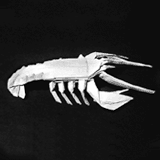|
||||||||

|
||
|
Though modular origami dates back hundreds of years, a folder named Mitsunobu Sonobe invented the locking mechanism that has made it popular. Variants of his unit, as well as completely new designs, are being invented all the time. Click here for a larger image of Mappin's cubes.
|
|
|
|||
|
If you fold along the lines the right way, you get a primitive lobster model with flaps of paper that correspond to each limb of the stick figure. From there, Lang says, he uses his origami experience - not the computer—to transform the flaps into claws that look as if they might pinch you if you get too close. "After a while, you learn the repertoire of how you put in elbows or feet," Lang says. "The hard part is getting the flaps in the right places to begin with." The secret of TreeMaker lies in the circles that have been drawn on the crease pattern. Each circle corresponds to one appendage. For example, the gigantic circle eventually turns into the lobster's tail. Inside each circle, the creases fan outward like the spokes of an umbrella. When collapsed, each of these "umbrellas" becomes a narrow, straight projection or flap, which Lang subsequently shapes into the appendage of choice. The computer packs the circles together as tightly as possible (to avoid wasting paper), while respecting the overall geometry of the lobster. This type of mathematical problem is called "constrained optimization"—finding the optimum design that satisfies certain constraints, such as the proportionality of the lobster's limbs. It's also exactly the type of problem Lang solves in his day job as a designer of laser systems. "Is it just lucky coincidence," Lang asks, "or is it that to a man with a hammer, everything looks like a nail?"
Click
here
to see a larger image of the lobster.
|
|||

|
|

|
|

|
| © Exploratorium |



